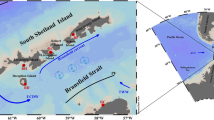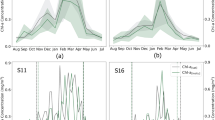Abstract
In waters surrounding James Ross Island (JRI), which is generally inaccessible, high chlorophyll-a concentration [Chla] can often be detected during summer periods by ocean color imagery. The region is influenced by a retreating sea ice edge from Weddell Sea and freshwater runoff from JRI glaciers, factors that probably trigger phytoplankton growth. In this work, we relate phytoplankton composition and biomass [Chla and carbon] with environmental factors in two successive late summer periods, in 2008 (1–3 March) and 2009 (17–20 February). Remote sensing data were used to corroborate the findings during those few sampling days. High surface [Chla] patches were observed through both remote sensing and field data (up to 7.61 mg Chla m−3 in 2009), and associated with a relatively shallow upper mixed layer (UML) (19–109 m in 2008 and 16–74 m in 2009). Sea surface temperatures were lower in 2008 (−1.19 to −0.62 °C) than in 2009 (−0.87 to −0.46 °C). Sea ice coverage was greater in 2008 than in 2009 summer, implying an earlier sea ice retreat in the latter year, when higher average [Chla] was obtained from field samples (3.3 mg m−3, compared to 1.5 mg m−3 in 2008). The eastern side of JRI appeared to be relatively sheltered from the dominant pattern of large-scale westerly winds. Diatoms dominated the phytoplankton community, with presence of large diatom species (e.g., Odontella weissflogii) typical of an advanced sea ice melt condition. Those blooms were sustained by a shallow UML associated with relative shelter from winds, due to proximity with the island.







Similar content being viewed by others
References
Abdi H (2007) The Bonferonni and Šidák corrections for multiple comparisons. In: Salkind NJ (ed) Encyclopedia of measurement and statistics. Sage, Thousand Oaks (CA), pp 103–107
Annett AL, Carson DS, Crosta X, Clarker A, Ganeshram RS (2010) Seasonal progression of diatom assemblages in surface waters of Ryder Bay, Antarctica. Polar Biol 33:13–29
Arrigo KR, van Dijken GL (2004) Annual changes in sea-ice, chlorophyll a, and primary production in the Ross Sea, Antarctica. Deep Sea Res II 51:117–138
Arrigo KR, van Dijken GL, Bushinsky S (2008) Primary production in the Southern Ocean, 1997–2006. J Geophys Res 113(C08004):1–27
Behrenfeld MJ, Boss E (2006) Beam attenuation and chlorophyll concentration as alternative optical indices of phytoplankton biomass. J Marine Res 64:431–451
Boyd PW (2002) Environmental factors controlling phytoplankton processes in the Southern Ocean. J Phycol 38:844–861
Buffen A, Leventer A, Rubin A, Hutchins T (2007) Diatom assemblages in surface sediments of the northwestern Weddell Sea, Antarctic Peninsula. Mar Micropaleontol 62:7–30
Costi J (2011) Estimativa do derretimento e descarga de água na porção norte da Península Antártica. Dissertation, Federal University of Rio Grande do Sul
Crawley MJ (2007) Tree models. In: Crawley MJ (ed) The R book, 2nd edn. Wiley, West Sussex, pp 685–700
Denis D, Crosta X, Zaragosi S, Romero O, Martin B, Mas V (2006) Seasonal and subseasonal climate changes recorded in laminated diatom ooze sediments, Adélie Land, East Antarctica. Holocene 16(8):1137–1147
Ducklow HW, Baker K, Martinson DG, Quetin LB, Ross RM, Smith RC, Stammerjohn SE, Vernet M, Fraser W (2007) Marine pelagic ecosystems: the West Antarctic Peninsula. Phil Trans R Soc B 362:67–94
Edwards R, Sedwick P (2001) Iron in East Antarctic snow: implications for atmospheric iron deposition and algal production in Antarctic waters. Geophys Res Lett 28:3907–3910
Fitzwater SE, Johnson KS, Gordon RM, Coale KH Jr, Smith WO (2000) Trace metal concentrations in the Ross Sea and their relationship with nutrients and phytoplankton growth. Deep Sea Res II 47:3159–3179
Garibotti IA, Vernet M, Ferrario ME, Smith RC, Ross RM, Quetin LB (2003) Phytoplankton spatial distribution patterns along the western Antarctic Peninsula (Southern Ocean). Mar Ecol Prog Ser 261:21–39
Garibotti IA, Vernet M, Smith RC, Ferrario ME (2005) Interannual variability in the distribution of the phytoplankton standing stock across the seasonal sea-ice zone west of the Antarctic Peninsula. J Plankton Res 27(8):825–843
Gomi Y, Umeda H, Fukuchi M, Taniguchi A (2005) Diatom assemblages in the surface water of the Indian Sector of the Antarctic Surface Water in summer of 1999/2000. Polar Biosci 18:1–15
Gordon AL, Mensch M, Dong Z, Smethie WM, de Bettencour J (2000) Deep and bottom water of the Bransfield Strait eastern and central basins. J GeophysRes 105:11337–11346
Grotti M, Soggia F, Ianni C, Frache R (2005) Trace metals distributions in coastal sea ice of Terra Nova Bay, Ross Sea, Antarctica. Antarct Sci 17(2):289–300
Hasle GR, Syvertsen EE (1996) Marine diatoms. In: Tomas CR (ed) Identifying marine diatoms and dinoflagellates. Academic Press Inc., London, pp 5–385
Hawes I, Brazier P (1991) Freshwater stream ecosystems of James Ross Island, Antarctica. Antarct Sci 3:265–271
Hewes CD (2009) Cell size of Antarctic phytoplankton as a biogeochemical condition. Antarct Sci 21:457–470
Hewes CD, Reiss CS, Kahru M, Mitchell BG, Holm-Hansen O (2008) Control of phytoplankton biomass by dilution and mixed layer depth in the western Weddell-Scotia Confluence. Mar Ecol Prog Ser 366:15–29
Hillebrand H, Dürselen CD, Kirschtel D, Pollingher U, Zohary T (1999) Biovolume calculation for pelagic and benthic microalgae. J Phycol 35:403–424
Holm-Hansen O, Kahru M, Hewes CD, Kawaguchi S, Kameda T, Sushin VA, Krasovski I, Priddle J, Korb R, Hewitt RP, Mitchell BG (2004) Temporal and spatial distribution of chlorophyll-a in surface waters of the Scotia Sea as determined by both shipboard measurements and satellite data. Deep Sea Res II 51:1323–1331
Kang S, Kang J, Lee S, Chung KH, Kim D, Park MG (2001) Antarctic phytoplankton assemblages in the marginal ice zone of the northwestern Weddell Sea. J Plankton Res 23:333–352
Lancelot C, Mathot S, Veth C, de Baar H (1993) Factors controlling phytoplankton ice-edge blooms in the marginal ice-zone of the northwestern Weddell Sea during sea ice retreat 1988: field observations and mathematical modelling. Polar Biol 13(06):377–387
Ligowski R, Godlewski M, Lukowski A (1992) Sea ice diatoms and ice edge planktonic diatoms at the northern limit of the Weddell Sea pack ice. Proc NIPR Symp Polar Biol 5:9–20
Loeb V, Hofmann EE, Klinck JM, Holm-Hansen O, White WB (2009) ENSO and variability of the Antarctic Peninsula pelagic marine ecosystem. Antarct Sci 21:135–148
Lund JWG, Kipling C, Le Cren ED (1958) The inverted microscope method of estimating algal numbers and the statistical basis of estimations by counting. Hydrobiologica 11:143–170
Marrari M, Daly KL, Hu C (2008) Spatial and temporal variability of SeaWiFS chlorophyll a distributions west of Antarctic Peninsula: implications for krill production. Deep Sea Res II 55:377–392
Menden-Deuer S, Lessard EJ (2000) Carbon to volume relationships for dinoflagellates, diatoms, and other protist plankton. Limnol Oceanogr 45:569–579
Mendes CRB, Souza MS, Garcia VMT, Leal MC, Brotas V, Garcia CAE (2012) Dynamics of phytoplankton communities during late summer around the tip of the Antarctic Peninsula. Deep-Sea Res I 65:1–14
Mendes CRB, Tavano VM, Leal MC, Souza MS, Brotas V, Garcia CAE (2013) Shifts in the dominance between diatoms and cryptophytes during three late summers in the Bransfield Strait (Antarctic Peninsula). Polar Biol. doi:10.1007/s00300-12-1282-4
Mitchell BG, Holm-Hansen O (1991) Observations and modeling of the Antarctic phytoplankton crop in relation to mixing depth. Deep-Sea Res 38:981–1007
Montagnes DJS, Berges JA, Harrison PJ, Taylor FJR (1994) Estimating carbon, nitrogen, protein, and chlorophyll a from volume in marine phytoplankton. Limnol Oceanogr 39:1044–1060
Montes-Hugo M, Doney SC, Ducklow HW, Fraser W, Martinson D, Stammerjhn SE, Schofield O (2009) Recent changes in phytoplankton communities associated with rapid regional climate change along the Western Antarctic Peninsula. Science 323:1470–1473
Moore JK, Doney SC (2006) Remote sensing observations of ocean physical and biological properties in the region of the Southern Ocean Iron Experiment (SOFeX). J Geophys Res 111:C06026. doi:10.1029/2005JC003289
Olguín HF, Alder VA (2011) Species composition and biogeography of diatoms in antarctic and subantarctic (Argentine shelf) waters (37–76°S). Deep Sea Res II 58:139–152
Palmisano AC, Garrison DL (1993) Microorganisms in Antarctic sea ice. In: Friedmann EI (ed) Antarctic microbiology. Wiley, New York, pp 167–218
Park MG, Yang SR, Kang S, Chung KH, Shim JH (1999) Phytoplankton biomass and primary production in the marginal ice zone of the northwestern Weddell Sea during austral summer. Polar Biol 21:251–261
Piatkowski U (1989) Macroplankton communities in Antarctic surface waters: spatial changes related to hydrography. Mar Ecol Prog Ser 55:251–259
Pisarevskaya LG, Popov IK (1991) Free-drifting icebergs and thermohaline structure. Glaciers-Ocean-Atmosphere Interactions (Proceedings of the International Symposium, St. Petersburg, September 1990). IAHS Publ 208:447–454
R Development Core Team (2013) R: a language and environment for statistical computing. Vienna: R Foundation for Statistical Computing. Available at http://www.R-project.org/. Version: 3.0.2
Rau F, Mauz F, De Angelis H, Jaña R, Neto JA, Skvarca P, Vogt S, Saurer H, Gossmann H (2004) Variations of glaciers frontal positions on the northern Antarctic Peninsula. Ann Glaciol 39:525–530
Robertson RA, Padman L, Egbert GD (1998) Tides in the Weddell Sea. In: Jacobs SS, Weiss RF (eds) Ocean, Ice and Atmosphere interactions at the Antarctic continental margin. Antarctic Res Ser, AGU, Washington, 75:341–369 doi: 10.1029/AR075p0341
Sañudo-Wilhelmy SA, Olsen KA, Scelfo JM, Foster TD, Flegal AR (2002) Trace metal distributions off the Antarctic Peninsula in the Weddell Sea. Mar Chem 77:157–170
Scott FJ, Marchant HJ (2005) Antarctic Marine Protists. Australian Biological Resources Study and Australian Antarctic Division, Canberra 572p
Sedwick PN, DiTullio GR (1997) Regulation of algal blooms in Antarctic shelf waters by the release of iron from melting sea ice. Geophys Res Lett 24:2515–2518
Sedwick PN, DiTullio GR, Mackey DJ (2000) Iron and manganese in the Ross Sea, Antarctica: seasonal iron limitation in Antarctic shelf waters. J Geophys Res 105:11321–11336
Smetacek V, Assmy P, Henjes J (2004) The role of grazing in structuring Southern Ocean pelagic ecosystems and biogeochemical cycles. Antarct Sci 16(4):541–558
Smith WO Jr, Nelson DM (1990) Phytoplankton growth and new production in the Weddell Sea marginal ice zone in the austral spring and autumn. Limnol Oceanogr 35:809–821
Smith RC, Baker KS, Vernet M (1998) Seasonal and interannual variability of phytoplankton biomass west of the Antarctic Peninsula. J Marine Syst 17:229–243
Sone T, Fukui K, Strelin JA, Torielli CA, Mori J (2007) Glacier lake outburst flood on James Ross Island, Antarctic Peninsula region. Pol Polar Res 28:3–12
Sournia A (1978) Phytoplankton Manual. UNESCO, Paris
Spreen G, Kaleschke L, Heygster G (2008) Sea ice remote sensing using AMSR-E 89 GHz channels. J Geophys Res. doi:10.1029/2005JC003384
Stickley CE, Pike J, Leventer A, Dunbar R, Domack EW, Brachfeld S, Manley P, McClennan C (2005) Deglacial ocean and climate seasonality in laminated diatom sediments, Mc. Robertson Shelf. Antarctica. Palaeogeogr Palaeoecol 227:290–310
Utermöhl H (1958) Zur Vervollkommnung der quantitativen Phytoplankton-Methodik. Mitt Internationale Ver Theoretische und Angewandte Limnologie 9:1–38
Vernet M, Martinson D, Iannuzzi R, Stammerjohn S, Kozlowski W, Sines K, Smith R, Garibotti I (2008) Primary production within the sea-ice zone west of the Antarctic Peninsula: I-Sea ice, summer mixed layer, and irradiance. Deep Sea Res II 55:2068–2085
Von Gyldenfeldt A-B, Fahrbach E, García MA, Schröder M (2002) Flow variability at the tip of the Antarctic Peninsula. Deep Sea Res II 49:4743–4766
Acknowledgments
This project is part of GOAL (Group of High Latitude Oceanography) and was supported by funding from CNPq (Brazilian National Council on Research and Development), MMA (Ministry of Environment) and the Brazilian Antarctic Program (PROANTAR). The authors would like to thank the Brazilian Ministry of Science and Technology (MCT) and the crew of the Brazilian Navy research ship “AryRongel” for their assistance and for contributions with all cruise activities. We are very grateful to Rafael Mendes for HPLC analysis. A.M.S. Detoni and M.S. de Souza were funded by CAPES Foundation. M.S. de Souza was granted by CNPq and is now receiving a research fellowship from CAPES.
Author information
Authors and Affiliations
Corresponding author
Rights and permissions
About this article
Cite this article
Detoni, A.M.S., de Souza, M.S., Garcia, C.A.E. et al. Environmental conditions during phytoplankton blooms in the vicinity of James Ross Island, east of the Antarctic Peninsula. Polar Biol 38, 1111–1127 (2015). https://doi.org/10.1007/s00300-015-1670-7
Received:
Revised:
Accepted:
Published:
Issue Date:
DOI: https://doi.org/10.1007/s00300-015-1670-7




